Nagasaki Prefecture is one of my favorite prefectures in all of Japan and having been to all prefectures, I think I can allow myself a judgement like this. Thus it was a pleasure to not only visit Nagasaki City again, but also other great places such as Gunkanjima, Omura and Hirado. My final stop in Nagasaki Prefecture was Shimabara City (島原市).
Shimabara is actually a peninsula east of Nagasaki City and can be reached easily by train from there in about 1.5 h and could also be done as a day trip. It takes much longer if you access it from Hirado like I did, but it’s possible.
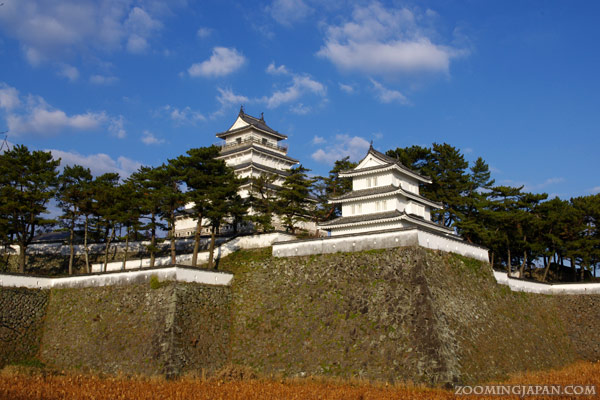
Shimabara Castle
I got up very early in the morning and my first stop was Shimabara Castle, of course! *g*
I could already see the castle from my hotel room. It’s also close to the train station and can be reached in about 10 minutes if you walk from there.
The castle was built during the early Edo Period (江戸時代) as the seat of the local feudal lord.
It was also a major factor that led to the “Shimabara Rebellion” (1637-1638) as it was much larger than other feudal domains of similar status. Its construction cost a lot of money, too.


Shimabara Castle was eventually destroyed during the Meiji Period (明治時代, 1868-1912). The buildings you see on the photos are concrete reconstructions from 1964.
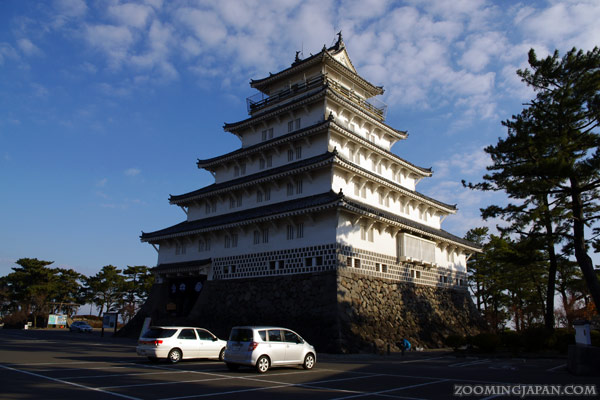
Quite unique is also that the city obviously has chosen functionality to be a priority when reconstructing the castle as there’s a parking lot RIGHT in front of the castle building!

Castle walls everywhere and in the background Mt. Unzen.

Close-up right before entering.
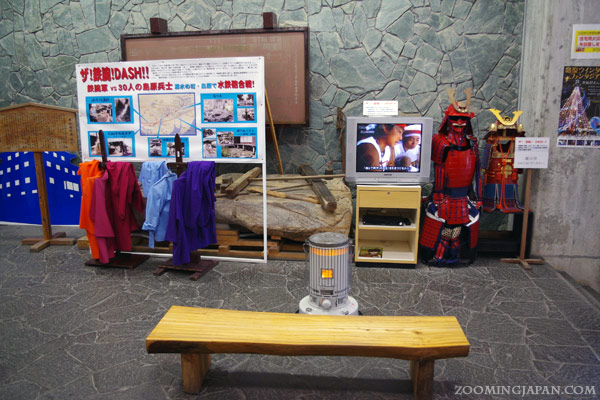
In the entrance area there was a little corner for kids to dress up as samurai and warrior to take photos.
Unfortunately, beyond that point photos weren’t allowed.
The castle museum displayed a collection of Christian artefacts that were excavated from the castle ruins as well as the typical armors and weapons.
I spent a long time in there. A lot of information was provided in English(!) about the Christian history in Shimabara – and I found that extremely interesting.
On the 5th floor you had the typical observation deck that offered an awesome view.

On clear days you can see over the ocean all the way to Kumamoto Prefecture.

It surely is a great view from up there!

Back outside I strolled around on the castle grounds. There were some freaky looking statues everywhere!

Here’s another one.

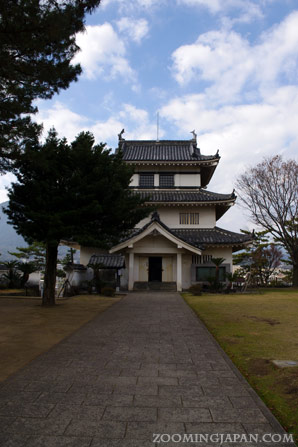
I really liked the statue that was looking up to the castle!
The ticket you purchase when entering the castle also allows you to enter the “yagura” (castle turrets) that also had interesting things to offer.
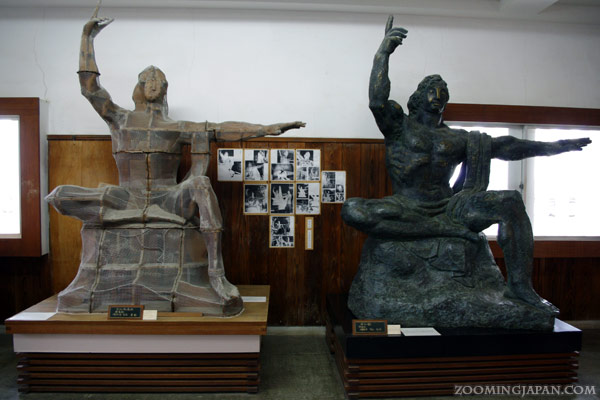
In the photo above you see the Seibo Memorial Hall. Displayed is the work of the famous sculptor Kitamura Seibo, the artist who made the Nagasaki Peace Park statue.
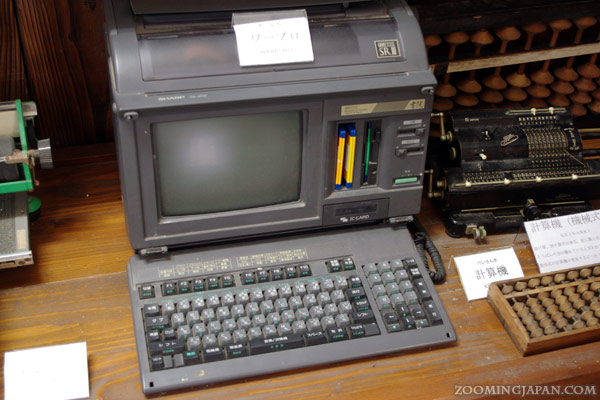
There was also a folk museum displaying items of daily life from the 20th century.
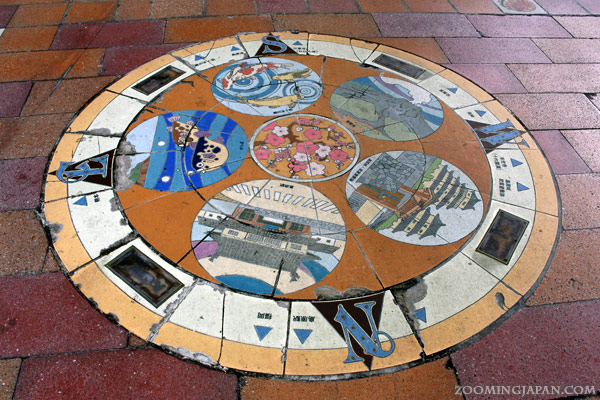
Shimabara’s lovely shopping arcade and Sleeping Nirvana Statue
After leaving the castle I entered a small shopping arcade on my way to the “Nirvana Statue”.

What I really liked were the colorful and cute “doors” of the shops that were closed.

Shimabara is also famous for onsen (natural hot springs) because of the nearby active volcano Mt. Unzen (more about that later).
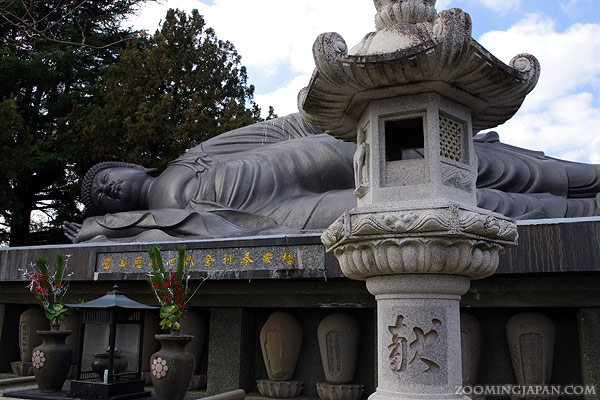
After walking through the shopping arcade for about 10 minutes I finally reached the sleeping Nirvana Statue.
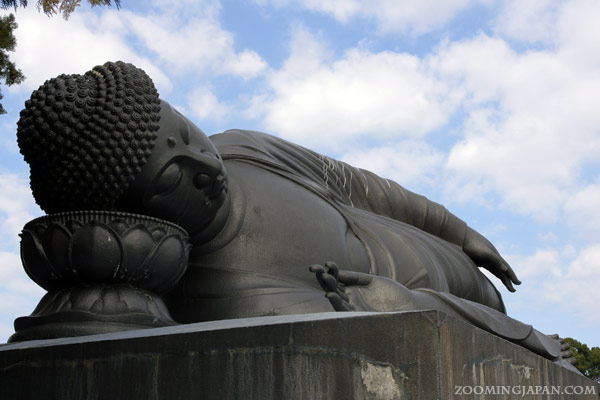
Truly a breathtaking sight. There aren’t that many in Japan, especially not outside!
Mt. Unzen
It was about 11 a.m. and I wanted to go to Mt. Unzen next. The area around the volcano is really unique and beautiful and there were also a few onsen resorts. Without a car your only choice is a bus that departs near the very small tourist information center. However, there are only a few buses per day, so plan accordingly.
I was EXTREMELY lucky that day. .gif)
As always when traveling I went to the tourist info center and asked for some pamphlets and if it was possible to visit Mt. Unzen with only half a day left.
The older lady was a volunteer and she was so excited to meet me (apparently they don’t get foreign visitors very often … on top of that Japanese speaking ones).
We talked for quite a while and she said she’d love to take me there, but she can’t leave the tourist info booth.
So, she called her husband (I felt sorry for him ) and didn’t give up until he agreed to take me. *LOL*
) and didn’t give up until he agreed to take me. *LOL* .gif)
I ended up with my private, local tour guide … and all of that for FREE!!!! .gif)
I felt so ashamed and told her many times, that it’s not necessary.
I never win arguing about kind offers of Japanese people…
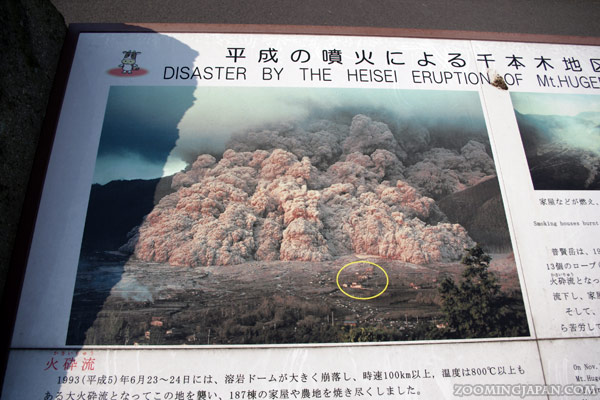
As we went by car, my guide stopped at all the interesting spots and also provided a lot of information that only locals know! It was really great!
Mt. Unzen is an active volcano. The last huge eruptions were from 1990-1995, destroying parts of Shimabara and killing several people. They didn’t rebuilt the destroyed houses. Nothing will be built there anymore as it’s too close to the volcano!
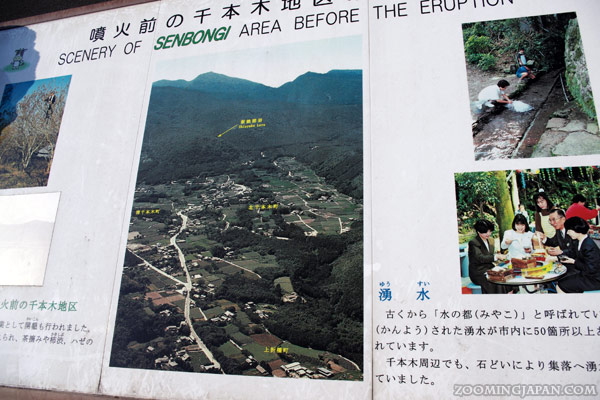
That’s all gone now! :(
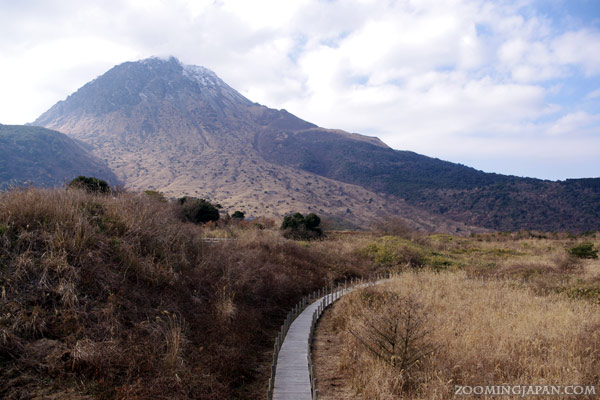
We were slowly getting closer to the volcano.
The landscape was also changing. Plants grow here that grow nowhere else!

These strawberries are just one example. They can ONLY be found there in Shimabara and it’s NOT allowed to pick them, but my guide did it nevertheless and had me try one.
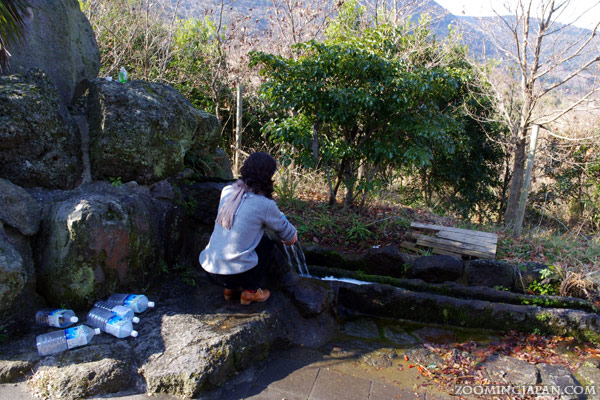
There’s also a water spring providing clear, healthy water that you can drink!
You can even buy it in supermarkets! Just have a closer look at the water you buy next time! Maybe it’s this one from Shimabara!

As we were going higher, the view became more and more breathtaking!
Unfortunately the sun was working against me, so taking nice photos was difficult.

We finally arrived near the crater.

From up there you could see the onsen resort “Obama”. Yes, that’s right! The area got a lot of publicity when Obama became president of the USA!
There’s actually one more Obama in Japan. It’s in Fukui Prefecture.

From the parking lot you could take a ropeway, but we didn’t. My guide had other plans and after the kind offer I just followed along! ^-^;
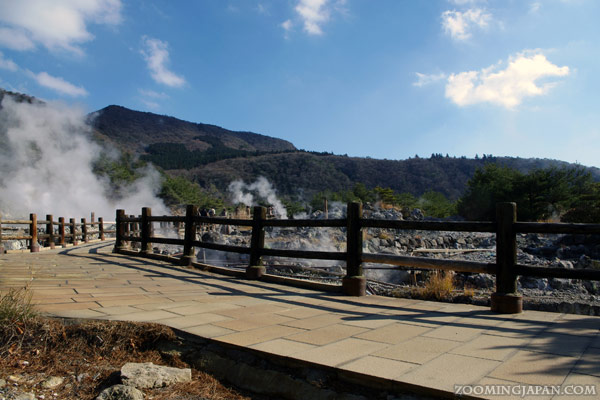
The Hells of Unzen
Just like in Beppu (Oita Prefecture) Obama also has its own “hells”: Unzen Jigoku, the Hells of Unzen.
In the Meiji Period, the town became one of Japan’s first tourist resorts popular among foreigners. Actually you can find a golf course that was the first in Japan, created by foreigners to enjoy their leisure time there!
The hells of Unzen are quite spacious and so I took my time to explore and enjoy the volcanic landscape.


Now you might think: “Wow, great! Even there you could find Christian influence?”
Actually the story behind that cross is really sad.
In the 17th century priests and Japanese Christians who didn’t want to abandon their faith were killed by being thrown into the boiling water of “the hells” after the failed Shimabara Rebellion.

And this doesn’t look very pleasant anymore. That’s not a hot spring temperature any of us would want to bathe in, right?

Mt. Unzen Visitor Center
At last we went to the Mt. Unzen Visitor Center. You’ll find information about the last eruption and its destructive power and effects on daily life as well as the unique flora and fauna that can be found.

Although I visited in winter, it wasn’t cold enough to observe this beautiful phenomenon.

Different seasons bring different colors. My guide told me that it’s especially beautiful in autumn with all the colorful leaves, so I guess that would be the best time to visit!
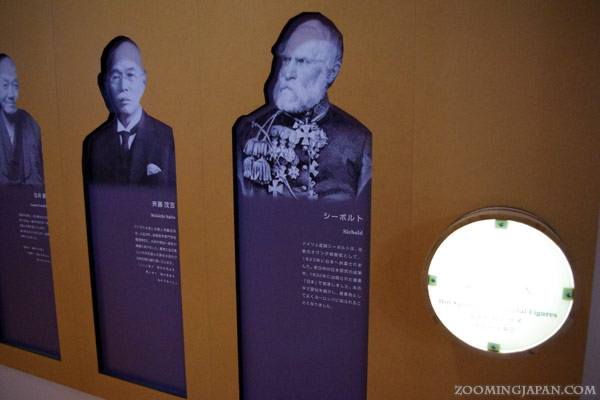
I even spotted Dr. Siebold again! I won’t go into details, but he was German and there’s a nice little museum in Nagasaki City if you want to know more about this great person! :) I’ll write more about him some other time.
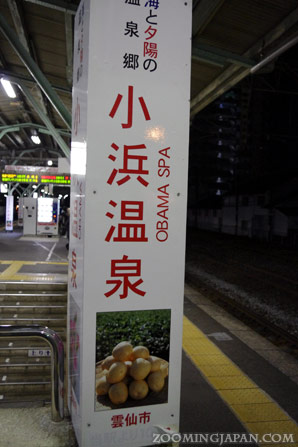
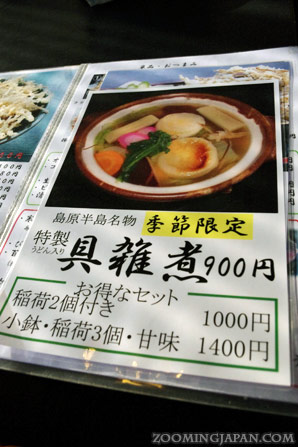
And then it was time to leave Obama. We both were hungry, so we went to eat dinner.

This is famous for Shimabara and the name is written on the menu above, but I forgot how to read it! ^-^;;
It was delicious and as it was winter, something warm was just right!
Of course I invited my guide, but he didn’t accept that I wanted to pay. He said if his wife gets to know about this, she’d be angry. .gif)
Instead we exchanged addresses and once I was back home I sent them a omiyage (typical food from my area) as a thank you gift!
And then I was already sitting in the train back home. My mind filled with great memories and my camera’s memory cards filled with tons of photos.
This was my awesome winter vacation in Kyushu.
I hope you enjoyed it as much as I did! .gif)



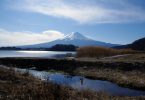

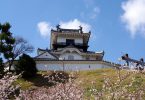

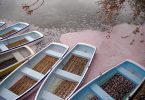
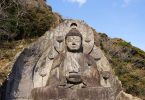
Unzen is a volcano I’ve still got to visit! Though I think nothing can beat Kagoshima with that volcano RIGHT IN FRONT of the city.
There are so many great volcanos here that I still want to visit!
Without a doubt Sakurajima is great, Mt. Aso is, too!
I’m a bit sad that I missed out on Mt. Zao (will post about that in a few days), but I make sure to visit there some day!
I liked the pictures a lot. Now I have to go to Shimabara the next time I visit Japan!
Ricardo, I’m glad you liked the photos! :D
Yes, you should definitely visit Shimabara if you have the chance to!
I’m sure you’ll like it there!
Great post as always. The cool thing about volcanic areas are the amazing onsen (hot springs) although I wouldn’t want to be thrown into that boiling hot one :) Shimabara Castle looks interesting, but don’t know about a car park right in font of the castle. Could spoil some good pics.
The best volcanic area with hot springs I’ve experienced so far was Kusatsu in Gunma Prefecture that I visited this August. I can’t wait to post about it!
I’m sure there are other great places like that out there that I still have to discover! *g*
Yes, the cars in front of the castle were a bit disturbing, but yet a unique sight!
Great article and nice picutres.
Thanks again, and again, and again. ;)
I’m glad to see that you seem to enjoy my blog posts!
Thanks for your nice comment! :luvit:
I have visited Kyushu only once after we had just married as one of honeymoon. Some 20 years ago. We landed Hakata Airplane and met my wife’s friend there. After that we went to Hirado Island there and stayed a hotel there. A wonderful night it was on our first night after the marriage. After that we journeyed around Kyushu by a rent-a-car. I regret now we hadn’t visited this Shimabara. But we traveled many places from Nagasaki to Kagoshima. Too many amusing and full of interesting places in Kyushu . By reading this article and many pictures I got a feeling to go to Kyushu and visit Shimabara in the future. Thank you for the sights.
Hello Narita!
Thank you very much for your comment!
I totally agree that Kyushu has so many beautiful sights to offer!
I have a hard time to decide what part of Kyushu I like the best, but I think I prefer the Western region with Nagasaki, Kumamoto and Kagoshima.
Oh, another castle on your list! :thumbup:
The view from up there looks pretty. I love the picture with the sun’s rays coming out from the clouds.
You’re so lucky to find a tour guide for free! I’m sure they appreciated what you sent them. :present:
The “hells” of Mt. Unzen sure sound “HELL” with that happened to the Christians thrown down there. I’m glad it’s all in the past.
That’s the smallest strawberries I’ve ever seen. :D
I saw you in one of the pics! :camera: :bleh:
Yes! ^___^
I really need to update my list after my summer vacation trip, though. I’m sure I can add about 15 more castles to it! Yay! :peace:
Me??!! Where?? Is it the one with the Mt. Unzen Visitor Center displayed? Even I can’t see myself there, though!? *g*
:ehehe: The one with PET bottles? :hihi:
I was the one who took that photo! Where do you see me in there? o__O;; ….
Ehh? I thought you’re the one sitting in front of the spring. :sweatdrop: :sweatdrop2:
No, that’s a Japanese woman I don’t know who got some water for herself there. ^-^;; ….
It’s funny, though. A lot of people think I’m Japanese when they see me from behind, so obviously it also works the other way round, huh? :hihi:
And here I thought you saw me in a window as reflection or something like that! *g*
This was posted before I began to visit your site, but thanks for linking it in the other post on the 47 Ronin. I read that during the time of the shimabara uprising that Japan was 6-8% Christian, so they had to kill a lot of Christians from 1638-1868 and after to keep that percentage down under 2%. What I can’t understand is why Christianity has failed so miserably to take root in Japan since the end of WWII, while it has flourished in Korea, China and the Philippines in comparison. I’m not so concerned about Christianity per se, but I just think it might be easier for America and foreigners from Europe to relate to the Japanese if there were more Christians in Japan. I begin to wonder what the Japanese leadership has done to stunt the growth of Christianity in Japan??
Your balance of ancient and modern subjects with the personal tragedies of the Christian oppression mingled with the eruptions of 1990-95 kept this posting really interesting and relevant. The pics of the terrain and the shops were masterfully done giving one the big picture as well as the attention to detail. It looks like you’ve been creating these wonderful posts for many years already and I just recently jumper on the bandwagon that is ZOOMING along!! That story about the information lady calling out her husband to guide you was incredible and once again reaffirms my belief that the Japanese are indeed kindred spirits!!
“I begin to wonder what the Japanese leadership has done to stunt the growth of Christianity in Japan??”
I could be wrong but I don’t think that they’re trying to stunt it. At least, not anymore.
Japan has had eight Christian prime ministers, including the current one:
1918-1921
1932-1932
1947-1948
1948-1954
1954-1956
1978-1980
2009-2010
2012-Present
A Christian Prime Minister has been in power for a roughly 25% of the last century, which is amazing when you consider that only about 1% of Japanese people are Christian.
On top of that, at least one member of the current Imperial Family is a Christian and the current Empress may or may not be for various reasons.
Elliot, great information! Didn’t realize that about the Prime Ministers.
There was some efforts during the Meiji era to make it illegal to operate Christian churches/schools and the Buddhists actively attempted to shut down Christian charities (sometimes with force) in the late 1800s. Then, I read about conflicts between militarists and Christians during the 1920-30’s; where some militarist fanatics assassinated and intimidated Christians that were opposed to the country’s warlike policies.
I also ran across an article about Christianity in Japan quoting a Christian missionary that had spent many years in Japan after WWII:
[That anecdote (confessions of a Japanese Christian that preferred not to attend church services in a church building because it felt foreign to him) underscores a truism about Christianity in Japan: despite its years of influence, the Christian religion is still considered foreign to Japan. Buddhism, which was introduced by the Chinese and, some say, the Koreans, remains closely integrated with Japanese life, as does Shinto, which in recent years has regained the “STATE SPONSORSHIP” it enjoyed during World War II. That “outsider” status limits the influence of Christianity, which still claims the allegiance of less than one-half of one percent of the population — the same level as 1945.]
I took that term “STATE SPONSORSHIP” to mean help from the government both financially and otherwise to give official standing to both the Shinto and Buddhist religion, and thus excluded Christianity from official acceptance by the government. Being tagged as a gaijin religion with all the negative connotations that the term gaijin means to the people of Japan has Christianity tagged as a religion that has lost face with the Emperor and the government. This is a serious lack of respect for Christianity and has doomed it to failure in Japan. So despite the thousands of missionaries that went to Japan over the years since 1945 and the millions of dollars given by Christians to help the Japanese over those same years, there has been ZERO growth in the percentage numbers of Christians in Japan for over 70 years. Compare that to any other Asian country (except North Korea) and you will see how strange that seems. It just seems impossible that this occurrence is a natural phenomenon and is not somehow being influenced by overt and covert actions taken by the Japanese government.
I would think that this phenomenon has its rooks in the Tokugawa exclusion edicts of 1635 that closed Japan for several hundred years and led to the annihilation of Christianity in Japan and coined the term gaijin. Japan feared Christianity after the Spanish conquest of the Philippines in the name of the Pope during the late 1570s.
I would also note that several US Presidents have proclaimed Christian faith and haven’t been very Christian with their policies or lifestyles, so technically being Christian in Japan might be tantamount to being aligned with the United States and could just be a political move to curry favor from America or that other politicians placed them as Prime minister during times of political corruption to make it seem like the government had cleaned up its act with a NEW “Christian” mentality. All of it could be explained away as politics in Japan and not a real statement of the status of Christians in Japanese politics!